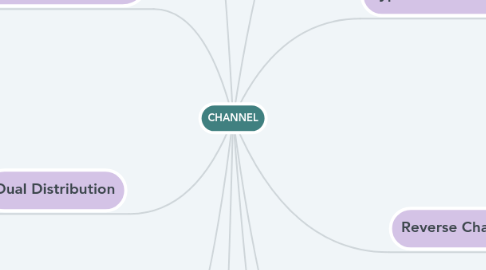CHANNEL
by Chia Huey Tung


1. Direct Selling
1.1. Direct channel
1.1.1. Carries goods directly from a producer to the business purchaser or ultimate user
1.2. Direct selling
1.2.1. Strategy designed to establish direct sales contact between producer and final user
2. Channels Using Marketing Intermediaries
2.1. Producer to wholesaler to retailer to consumer
2.2. Producer to wholesaler to business user
2.3. Producer to agent to wholesaler to retailer to consumer
2.4. Producer to agent to wholesaler to business user
2.5. Producer to agent to business user
3. Dual Distribution
3.1. Movement of products through more than one channel to reach the firm’s target market
3.2. Example: Nordstrom sells through stores, catalogs, and the Internet
4. Major Transportation Modes
4.1. Railroad
4.2. Water carrier
4.3. Motor carrier
4.4. Pipelines
4.4.1. Advantages: -Low maintenance -Dependable
4.4.2. Disadvantages: -Few locations -Accommodate only a small number of products -Relatively slow
4.5. Air freight
5. Distribution intensity
5.1. Intensive distribution
5.2. Selective distribution
5.3. Exclusive Distribution
6. Four functions of marketing channels:
6.1. Facilitating the exchange process by reducing the number of marketplace contacts necessary to make a sale
6.2. Adjusting for discrepancies in the market’s assortment of goods and services via sorting
6.3. Standardizing exchange transactions by setting expectations for products
6.4. Facilitating searches by both buyers and sellers
7. Types of Marketing Channel
7.1. Marketing intermediary
7.2. Resellers
7.2.1. Wholesaler
7.2.2. Retailers
7.3. Brokers
7.3.1. Agents
7.4. Facilitators
7.4.1. Transportation companies
7.5. Service firms market
7.5.1. Haircuts, manicures, and dental cleanings all operate through short channels
8. Reverse Channels
8.1. Growing importance because
8.1.1. Rising prices for raw materials
8.1.2. Increasing availability of recycling facilities
8.1.3. Passage of additional antipollution conservation laws

